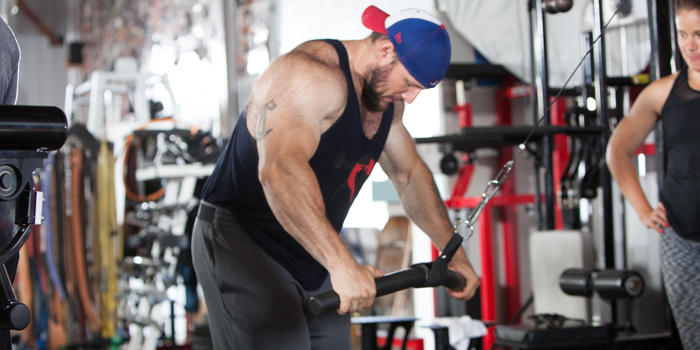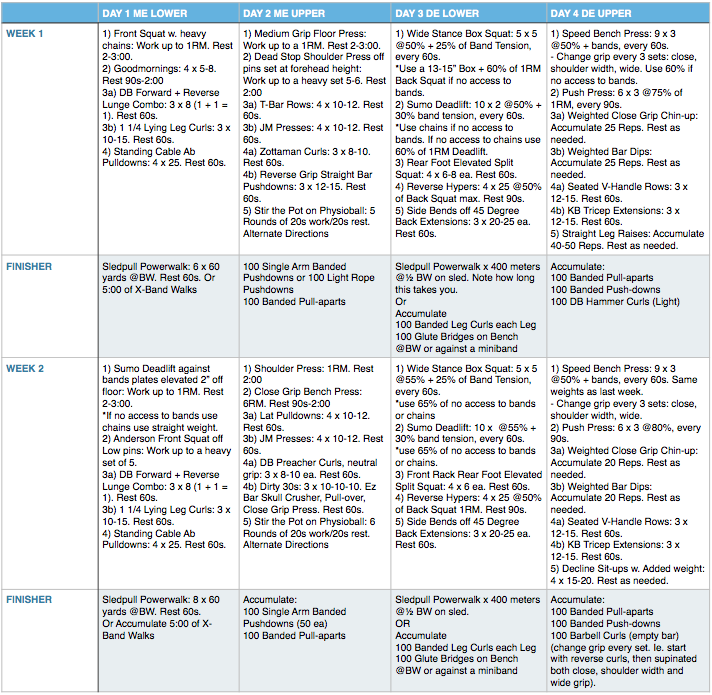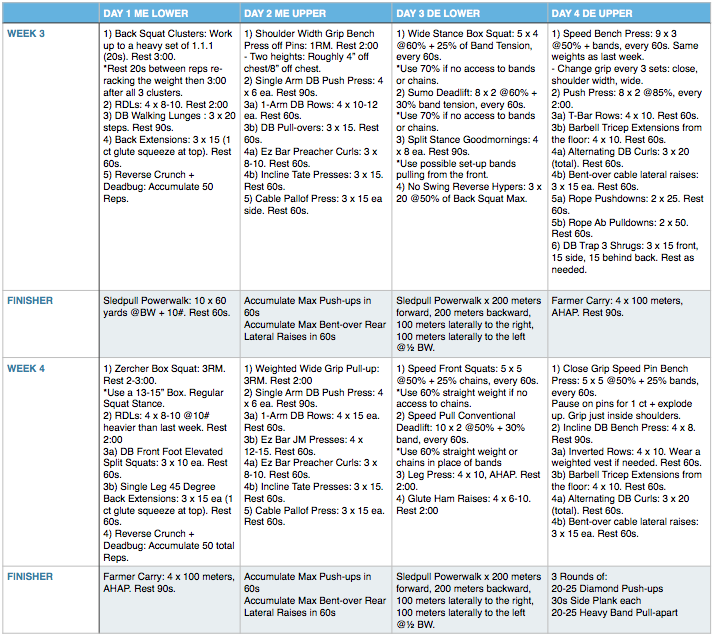
The conjugate system, made popular by Louie Simmons, is one of the most versatile training systems for a number of reasons. The system features a balance of training modalities on a weekly basis, meaning you’re not just lifting maximally or in a linear fashion; there is also a high degree of variance on a monthly basis. This means you’ll be exposed to different variations, which will serve as a vehicle to build your base while allowing you to become more resilient to be able to later tolerate higher volume. Because we are constantly rotating variations, you’ll be able to discover and identify weak links in the chain and exploit your lagging muscle groups. Although this system has been made popular by powerlifters, everyone from bodybuilders to strength athletes can benefit from it, as well as athletes that have some time training under their belt and know their way around the barbell.
One of the unforeseen aspects of the conjugate system is that you’ll spend 80% of your training in the form of “special exercises”, namely single-joint exercises for hypertrophy, and kick your lagging muscle groups in the butt. Even if you’re not aware of where your weaknesses lie, you’ll be exposed to hundreds of variations (yes, I said hundreds), through which it will be relatively easy to identify which variations carry over to compound movements. In this sense, it will be easy to see correlations between movements used and how much your lifts have improved by upon retest.
RECENT: Conjugate Programming for the General Population
With that said, it’s recommended that you have current training maxes to compare to. For those of you that may not be as concerned with your strength numbers, this aspect of the system ties into developing inter- and intra-muscular coordination and will allow you to develop higher threshold motor-units, which will set the stage for gaining more lean muscle mass. Gaining strength and size go hand-in-hand, and this aspect of the system creates a synergy to optimize your response to the training. Moreover, the balance between maximal lifting and lifting for force production will help facilitate recovery and ensure that you’re not burning the candle at both ends.
How does this translate to someone that just wants a bigger set of guns? Incredibly well, actually, due to the fact we are going to spend the bulk of our training sessions performing hypertrophy work to bring up our primary movers. The start of each training session will be devoted to either a max effort exercise (ME) that rotates weekly or a dynamic effort (DE) variation that rotates every three weeks. Keep in mind that the ME and DE methods only make up 20% of our total training. With the max effort method, our total work volume is relatively low but higher intensity, whereas our dynamic effort work volume is considerably higher, but we are utilizing submaximal loads working for maximal velocity. These sessions are done with 72 hours between each other to allow for complete CNS recovery. After your ME or DE work has been completed, the remainder of your training sessions will be devoted to special exercise work. Again, bringing up our primary movers is the goal with a handful of variations that allow us to avoid adaptation and becoming mentally stale with the same training.
Extreme training sessions are separated by 72 hours (Monday and Thursday for lower body sessions and Tuesday and Friday for upper body sessions). This programming utilizes accommodating resistance; however, if you do not have access to the use of bands and chains, you simply negate their use and modify the percentage work. I’ve seen many commercial gyms coming around to the idea of having different selections of equipment to accommodate everyone’s needs, but buying a couple sets of chains is relatively inexpensive and will provide some variance to your training.
Program Notes
- This program can be done on Monday, Tuesday, Thursday, Friday or Monday, Wednesday, Friday, Saturday. The key component is ensuring we have 72 hours of recovery between ME and DE upper training sessions.
- If you have the access to bands and chains we will utilize them, but they are not required.
- Extra conditioning work can be added two to three times per week in the form of sled work and loaded carries. These sessions should be non-invasive and not interfere with our other training.
- You will see the use the antagonistic supersets for our accessory work. This will ensure we are bringing up our primary movers and keeping our training sessions as efficient as possible.

As you can see, there is almost a constant rotation of variance within the program, which will keep your body and mind fresh. This template will also allow you to add in extra conditioning (if needed) on off days, or extra GPP work can be included on these days, but sessions should be kept more aerobic in nature in terms of maximal heart-rate (65-75% of MHR), and not interfere with other training modalities. The finisher work is optional or can be done in a separate session or day if needed. Overall, these training sessions should last no longer than 60 minutes.
There you have it, a bulletproof system for improving body composition, getting strong as you-know-what, and staying mentally fresh with variable training. This type of programming works wonders for athletes of a wide range of abilities, so you don’t need to be a geared powerlifter to incur the benefits. The key aspects of this programming are adding volume to single-joint movements, consistent variance with max effort work that allows us to constantly hit personal records, and allowing for the necessary recovery between harder training sessions.
Jason is a Certified Strength and Conditioning Specialist and has been coaching athletes from all walks of life for over 12 years. Jason is a former gym-owner and now owns Box Programming, a service that provides programming to box programming Affiliates as well as strength and conditioning facilities that serve the general population all over the world. Jason is a Combat Veteran.











3 Comments